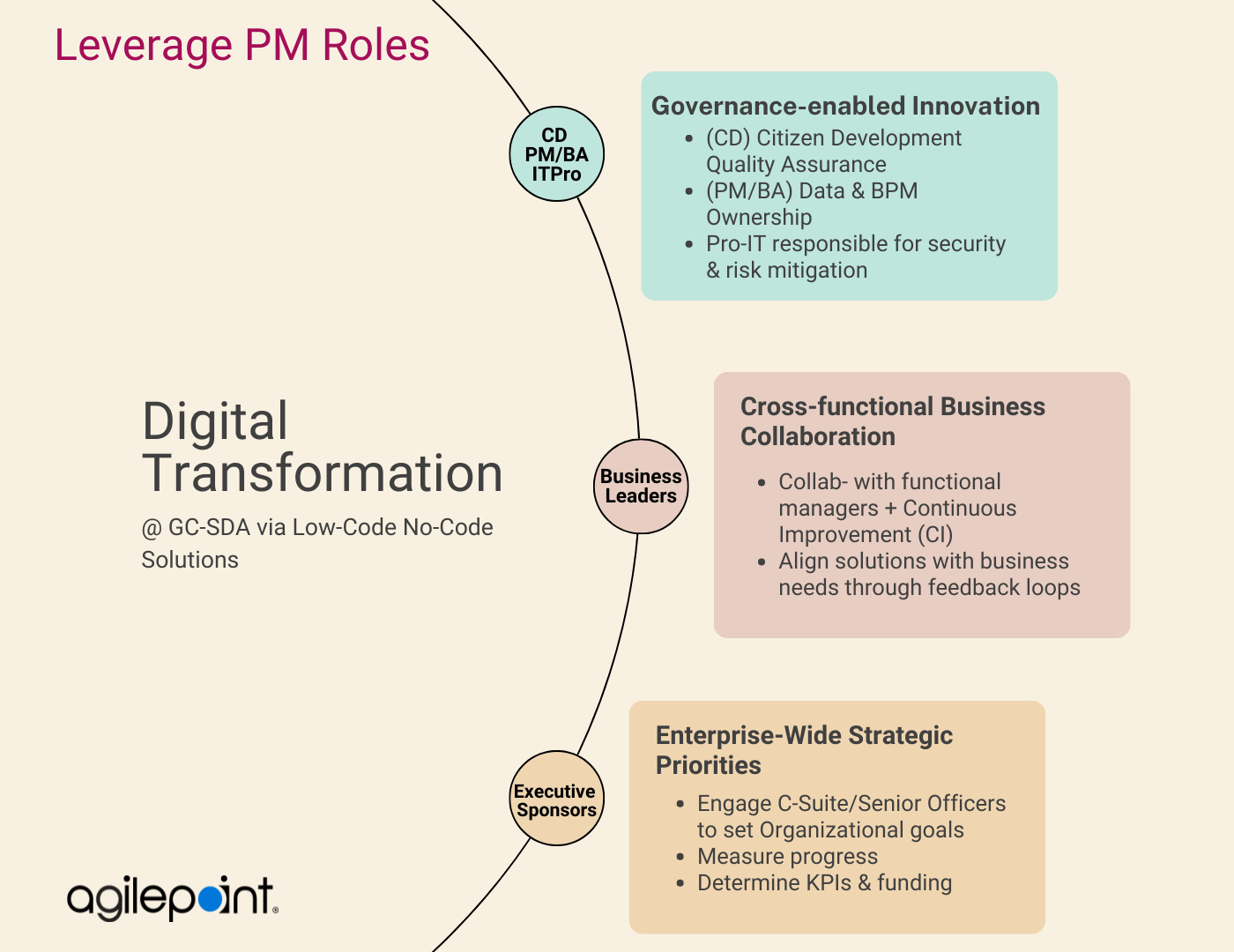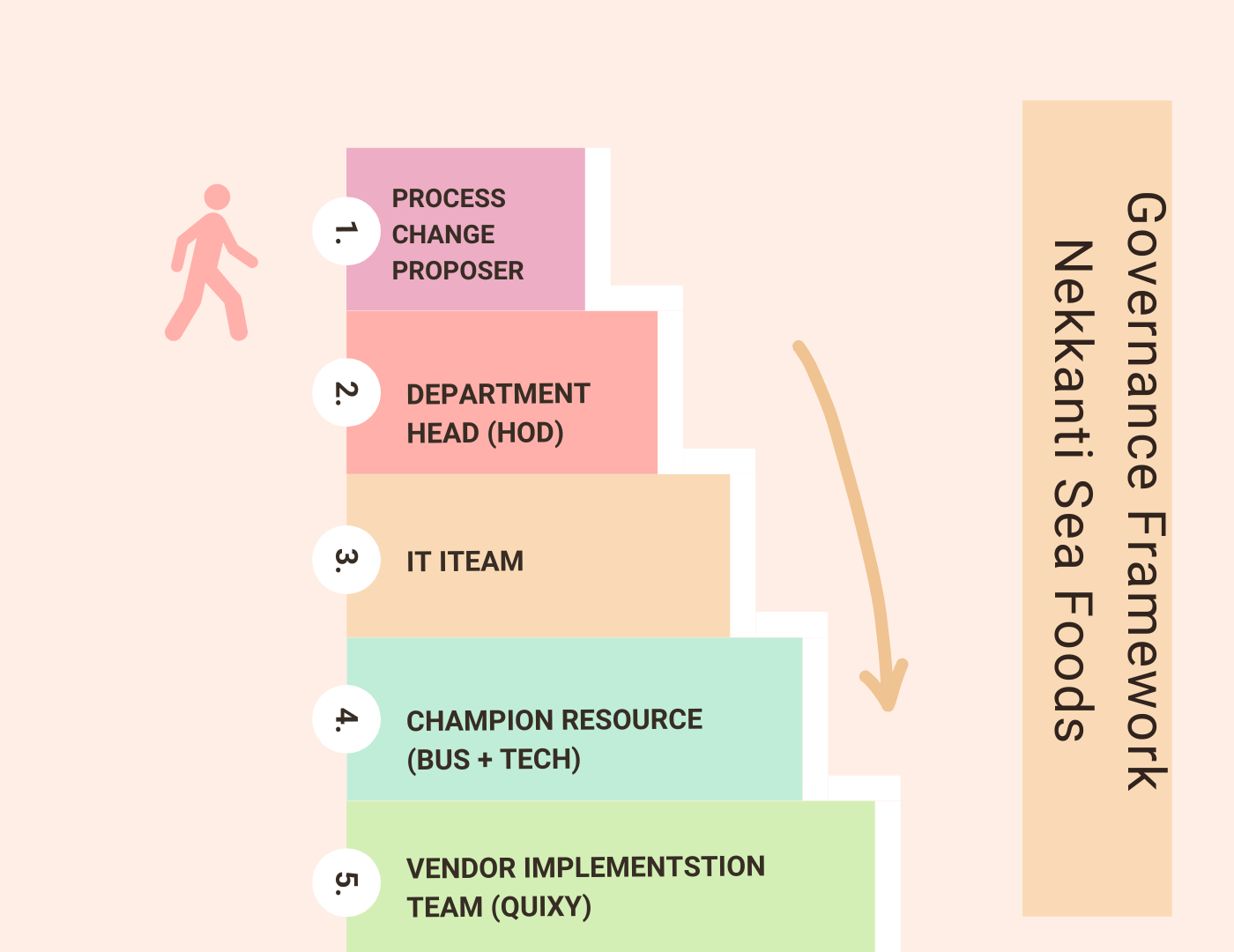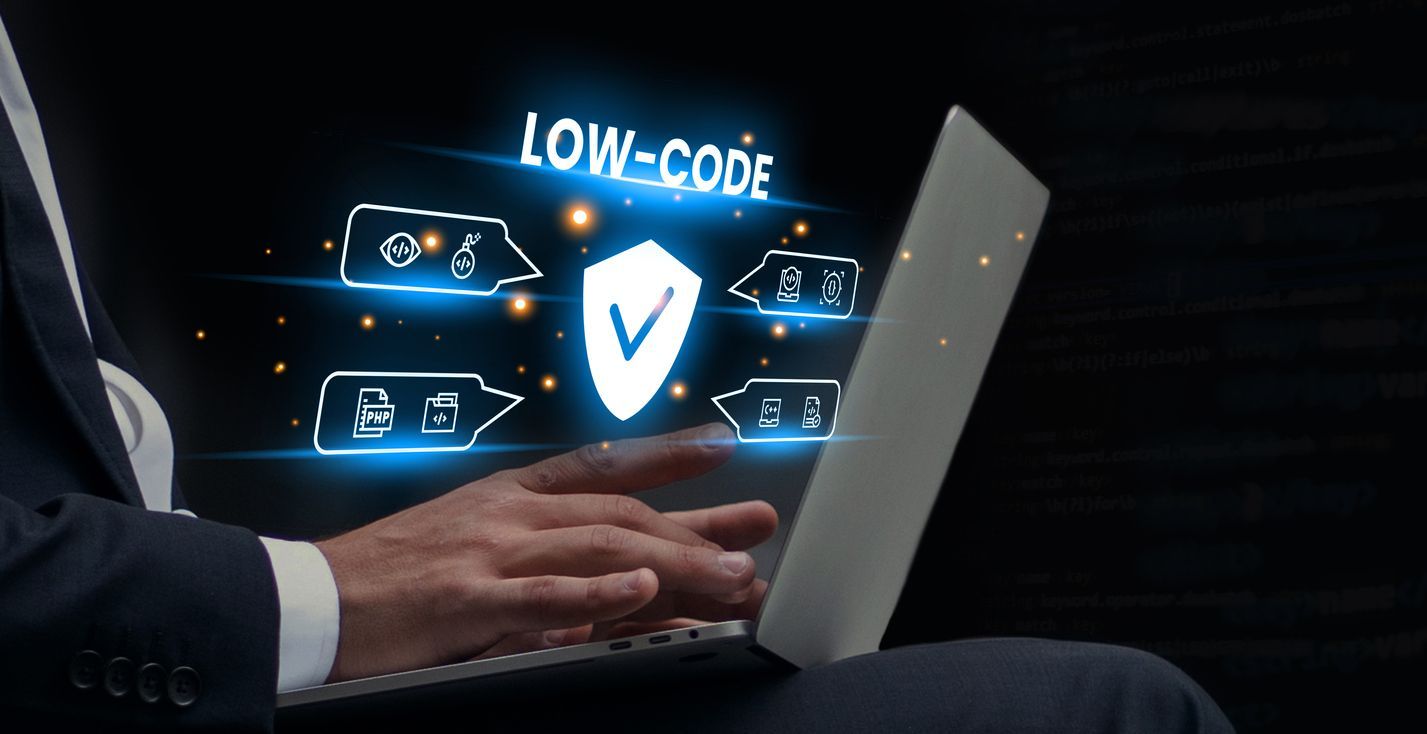In October this year, six weeks before Project Management Institute’s Global Summit 2022, four Project Management professionals spoke at a webinar on “The Role of Project Management and its importance in implementing new technologies during Digital Transformation.” Given 30 minutes to leave viewers with a roadmap, the speakers from two companies shared their journey of implementing enterprise Citizen Development projects. They also spoke about Project and Program Managers using their project management expertise to contribute to and sustain citizen development.
As such, they propose five best practices to make citizen development projects sustainable, which include:
- Determine needs and clarify objectives
- Find the right software solution
- Prioritize project governance
- Implement project management processes
- Ask the right questions before starting each citizen developer-led application project
-------------------------------------------------------------------------------------------------------------------------------------
Project Management Institute (PMI) hosted a webinar on the “Role of Project Management and its importance in implementing new technologies during Digital Transformation.”
Bailey Truesdale, Partner Success Specialist at the Project Management Institute (PMI) moderated the session. She gave a short introduction of citizen development and the PMI Citizen Developer foundation course before jumping into speaker introductions.
Bailey was joined by low-code and no-code business leaders, Brian Schimpf, GDPR and Health Analyst and Katherine Walton, Business Process Manager at General Conference of Seventh Day Adventists (GCSDA), an AgilePoint customer. She was also joined by Guru Prasad, Head of Customer Success at Quixy, and their customer Mohan Krishna at Nekkanti Sea Foods.
The speakers reiterated the crucial role of project management processes in implementing Citizen Development projects. It might not be a familiar concept, but a necessary one to succeed in implementing a citizen development program at an enterprise level.
Here are the key takeaways:
1. Determine the needs and clarify objectives
The panelists emphasized the importance of determining your project needs upfront.
Need analysis is an essential tool we all know about; however, with the rise of new technologies, it's helpful to go back to the basics and ask what needs the project would serve or what requirements we want to satisfy by using new technology.
Project managers and Citizen Developers from GC-SDA and Nekkanti Sea Foods provided practical examples demonstrating their use of Citizen Development to unlock innovation.
For instance, GC-SDA's circumstances were unique as it ran mission-critical global operations for 14 divisions. However, it did not afford to hire a team of expensive-to-hire professional developers to implement its digital transformation initiatives. Furthermore, the team wanted dynamic operational capabilities to respond to changing business and operational needs.
GC-SDA also desired to keep the HR operations adaptable to policy changes because the organization ran international HR operations with a small team of technical staff.
Katherine Walton, Business Process Manager at GC-SDA laid out four components of the organization’s Citizen Development program before transforming the HR operations:
- Identified Challenges
- Laid out Goals
- Determined desirable capabilities of the Citizen Development platform
- Shortlisted Use Case: New Hire Tracking System for Business Users Challenges
- How to provide a detailed overview and status of each step in the hiring process?
- How to measure the effectiveness of the hiring process?
Challenges
- How to provide a detailed overview and status of each step in the hiring process?
- How to measure the effectiveness of the hiring process?
Goals
GC-SDA clarified its core objective to be "digital Transformation of its critical business processes and modernization of its I.T. ops."
The meta-goal was further divided into sub-goals like:
1. Automate the system as much as possible to increase efficiency and prevent errors
2. Reduce technical debt by using a Low-Code No-Code solution to work in collaboration with business users and ProIT
- Previous solutions were high in cost
- IT Human Resources
- The end goal was to transition from only a pro-developers team to a pro-dev + Citizen-dev team
- Licensing Cost
- Replace high-cost legacy BPM and automation solutions with modern BPM and Citizen Development platform
Hence, we see a transparent approach of the GC-SDA team in determining its needs. The team further identified the capabilities of a new Citizen Development platform.
2. Find the right software solution
GC-SDA desired a tool that would support its specific needs for the HR modernization project:
- A tool that integrates with GC-SDA’s existing systems (cloud-based and on-premises)
- Supports smaller development team
- Citizen Developer/Business Analyst, 1 Project/Process Manager, and 1 Professional IT Service Provider
- LCNC solution that supports CD (empowers the Project Manager and Business Analysts to be more integrated into the application development cycle(supports CD)
- Strong governance (granular security for applications and reports) and ability to run analytics on running apps
- Mobile application development capabilities

Critical Considerations before implementing an LCNC solution for a large organization
- How will this new technology improve us; what is the innovation we want to achieve through the new technology?
- How drastically can the software solutions be implemented?
Similarly, Nekkanti Sea Foods also crystalized its automation needs by identifying the challenges it faced, and the goals it wanted to achieve;
Challenges
- Paper-based recording of data; highly error-prone
o Usually took 24hrs to transfer data from regional offices to corporate headquarters
o Lack of the ability to see real-time data
- Information Silos proliferation
- No Single source of truth about operational data
- Silos of Performance measurement & management resources
Goal
A scalable app dev and Business Process Management (BPM) tool that can rapidly automate and deploy processes across multiple sites without having to deploy on-site IT infrastructure
3. Prioritize project governance
Project Governance ensures that we know what we are accountable and responsible for. To that end, Katherine Walton of GC-SDA emphasized the importance of laying out the governance structure for the application projects under the Citizen Development program.
For instance, GC-SDA shared the governance structure it used to develop and implement its Citizen-developer apps.
- Scalable and sustainable Citizen Development with Quality Assurance
- Data and Business Process Management/Ownership by Project Manager/Business Analyst
- Security and Risk Management through ProIT

However, governance frameworks are not “one-size-fits-all.
Hence, Nekkanti Sea Foods used a different governance structure whereby every Citizen Development initiative or app passes through five people and respective teams.

1. Process change proposer: This person identifies manual activity or process to be re-engineered. The change proposer identifies if the proposed process can be implemented via Quixy or any other automation tool. The person also prepares a process map (As-Is & To-be) and present to HoD.
2. Department head (HoD): The Head of Department must prepare the business case for the Citizen Development app (and the proposed process change). HoD also finalizes input for the automated workflow/UI design for the IT team (prepared in the vendor’s Low-Code platform, in this case, Quixy).
3. IT Team: The IT team is responsible for understanding the requirements of Department Head. It also helps develop the app.
4. Champion Resource (Business + Technology): In this governance setup, the Champion resource with business and tech exposure ensures the availability of on-demand information. However, the most crucial aspect that the I.T. team handles is maintaining the inventory of apps developed by Citizen Developers.
- Quixy Implementation team: The vendor team assists and advises throughout the app development process, resolution of bugs, and deployment.
According to Nekkanti Sea Foods, the organization clubbed together 3-4 high-impact use cases (process changes). It implemented them using a lifecycle approach that involved design, testing, and production rollout in eight weeks.
4. Implement project management processes
Another best practice we learned about from this webinar was the use of project management (PM) processes. For instance, typical project phases include:
- Initiation
- Planning
- Execution
- Closing
Similarly, a project manager’s approach guides us that there are several knowledge areas one should consider while implementing citizen development projects:
- Integration Management
- Scope Management
- Time Management
- Cost Management
- Quality Management
- Resource Management
- Communication Management
- Risk Management

Hence, thinking through these project management processes helps keep Citizen Developer-led application projects on track.
5. Ask the right questions to succeed
Automation leaders from GCSDA and Nekkanti Sea Foods shared the importance of clarifying the objectives of your digital transformation projects. One way to achieve that is by asking the right questions.
For instance, for Nekkanti Sea Foods, it was essential to achieve an agile operating model at the strategic level; however, its objectives and questions helped it accomplish that. It clarified three aspects of its operational excellence initiative;
· Robust Value Chain
· Digital Operations Excellence
· Better Organizational Culture
It further asked pertinent questions under each category of objectives. For instance, for a robust value chain, the leaders asked:
- ·How would a Citizen app help build the desired robustness in the value chain? (Supplier performance, digitization of supply chain, customer intelligence)
- What key performance metrics would a Citizen Developer app drive for operations performance management? (Process Digitization, performance management, and activity digitization)
- What organizational culture factors would a new application imitative impact? (Innovation, Connectivity and collaboration, and Digital Empowerment)
The webinar attendees also asked a few crucial questions. We will provide answers to these questions in our next blog article. For reference, we are reproducing the questions below and short answers that speakers gave:
1. How to become a Citizen Development; which PM methodology you used?
a. Traditional Agile
b. 3 Weeks sprints
c. 1 Week user feedback
2. Which tool was used by panelists, and what were the lessons learned?
- AgilePoint
- Quixy
3. What is the optimal governance structure or strategy?
a. In-house IT
b. Enterprise-Wide Dev Infrastructure
c. Information Security Oversight Committee HQ and across the globe
4. How to provide long-term support for Citizen Development apps?
a. What if the developer leaves without documenting the apps
b. Are the processes handed over to IT for support?
5. How do you ensure the Quality Assurance (QA) of the system?
- Citizen Developers can test the system
- Usually, we come across implementation issues
- Agile methodology
6. How did you implement the solution by piloting it in one go?
a. It depends on the complexity
b. Non-complex
c. Complex
i. PoC
ii. Platform Subscription
7. What kinds of skills are required to develop automation apps?
a. How to design a form?
b. How is a data-table designed?
c. Training by LCNC provider
Are you ready to reengineer your business
automation processes?

A modern process automation and orchestration platform that enables you to open up and seize new business opportunities, supercharge innovation, unlock new levels of efficiency and productivity, and deliver the experiences that help you win.
Follow Us
Platform

Automate business processes and workflows at scale. AgilePoint helps enterprises democratize and accelerate digital transformation, reduce technical debt and future-proof ROI.
Resources
© 2023 AgilePoint. All rights reserved.



